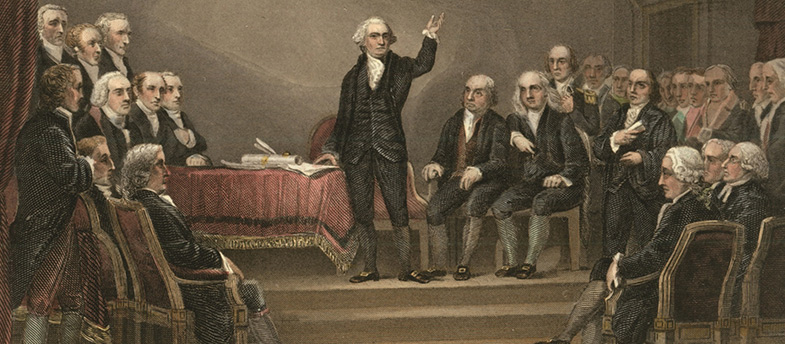In September 1786, a call was made in Annapolis for the states to convene in Philadelphia the following May to discuss amendments to the Articles of Confederation. However, it was merely an invitation—attendance was not guaranteed. The biggest challenge lay ahead for two key advocates of the convention: Alexander Hamilton and James Madison. They knew that getting delegates to attend and take the meeting seriously would be an uphill battle. But there was one man who could change everything just by showing up—George Washington.

Washington’s presence would immediately elevate the convention’s status from a regional discussion to a national event. But convincing the revered general to step out of retirement was easier said than done.
The Persuasion Campaign Begins
Shortly after the Annapolis Convention, Edmund Randolph, Virginia’s governor and a well-connected political figure, traveled to Mount Vernon. His mission was clear: persuade Washington to attend. Randolph came from a powerful Virginia family, with ties to the highest levels of colonial governance. Yet, despite his political clout and close friendship with Washington, he left Mount Vernon empty-handed.
Then came Madison. He spent three days at Washington’s estate, debating, persuading, and even pleading. Still, Washington was unmoved. As 1786 came to a close, he officially declined Virginia’s nomination as a delegate. His reasons? First, he had just refused an invitation from the Society of the Cincinnati, an organization of retired officers, to attend a meeting in Philadelphia at the same time. If he rejected his fellow soldiers but agreed to a political convention, it would hurt their feelings. Secondly, and more importantly, the Philadelphia Convention lacked legitimacy. The Annapolis meeting had not been officially sanctioned by Congress, making any proposed changes to the Articles of Confederation seem like a radical move—perhaps even treasonous.
The Turning Point
Madison wasn’t about to give up. He countered Washington’s first concern by arguing that national interests far outweighed personal obligations to retired officers. For the second issue, he set out to secure official congressional authorization for the convention. By February 1787, thanks to the efforts of Madison and Hamilton, Congress gave its blessing, removing Washington’s primary objection.
Around the same time, the Shays’ Rebellion erupted in Massachusetts, sending shockwaves through the young nation. The insurrection underscored the dangers of a weak central government and changed many minds—including Washington’s. The rebellion made it clear that without a stronger federal structure, the fledgling republic was on the brink of chaos.
On March 28, Washington wrote to Randolph, finally accepting his role as Virginia’s chief delegate. But he made one thing clear: he wasn’t going to Philadelphia just to tweak the Articles of Confederation—he was there to push for a complete overhaul.
The Reluctant Statesman Takes Charge
Washington’s decision electrified the convention. When he arrived in Philadelphia on May 13, 1787, the city erupted in celebration. Cannons fired, church bells rang, and citizens cheered their returning hero. Washington, however, remained his usual reserved self, choosing to stay with his longtime friend Robert Morris rather than accept lavish accommodations.
One of his first acts in Philadelphia was visiting Benjamin Franklin, the only figure in American politics who could rival his stature. Franklin, at 81, was the elder statesman of the revolution and had recently returned from France, where his diplomatic efforts had secured crucial alliances. Some even speculated that Franklin might challenge Washington for the role of convention president, but Franklin himself had no such ambitions. On May 25, Washington was unanimously elected president of the Constitutional Convention.
Legacy and Influence
Washington’s leadership at the convention was pivotal. Though he rarely spoke, his presence alone kept the debates focused and dignified. His endorsement of a stronger central government provided legitimacy to the Constitution, helping to sway skeptical delegates. Without his participation, it is uncertain whether the new framework of government would have ever come to fruition.
This moment also marked the beginning of Washington’s reluctant return to public life, culminating in his election as the first President of the United States. His concern about unchecked democracy leading to tyranny proved prophetic, as the Constitution sought to balance power through checks and balances. Even today, his warning about the dangers of both excessive democracy and unchecked authority remains relevant in political discourse.
In the end, Washington was right to be wary of power. But history would show that, at the right moments, his willingness to wield it made all the difference.

No comments yet.